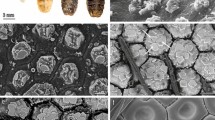Abstract
Some modern elementary biology texts inform their readers that arthropod cuticles are composed exclusively of the polysaccharide, chitin. But it has been known since 1823 that there is another major nitrogenous component which we now know to be protein. The first to measure the amount of protein in the cuticle was Gottfried Fraenkel. His publication with Rudall in 1940 alerted the scientific community to the fact that about 40% of the dry weight of fly larval cuticle is protein, much of which is soluble in boiling water. They also discovered that less than 10% of the dry weight remained soluble in boiling water after the puparium was tanned, but that protein could still be extracted with 5% KOH, leaving the chitin behind.
Access this chapter
Tax calculation will be finalised at checkout
Purchases are for personal use only
Preview
Unable to display preview. Download preview PDF.
Similar content being viewed by others
References
Fox, F. R., Seed, J. R., Mills, R. R., 1972, Cuticle sclerotization by the American cockroach: Immunological evidence for the incorporation of blood proteins into the cuticle, l. Insect Physiol. 18: 2065-2070.
Fraenkel, G. Rudall, K. M., 1940, A study of the physical and chemical properties of the insect cuticle, Proc. Roy. Soc. G, 129: 1 - 35.
Fraenkel, G. Rudall, K. M., 1947, The structure of insect cuticles, Proc. Roy. Soc. J, 134: 111-143.
Fristrom, J. W., Hill, R. J., and Watt, F., 1978, The procuticle of Drosophila: Heterogeneity of urea-soluble proteins. Biochemistry 17:3917 - 3924.
Hackman R. H., 1953, Chemistry of insect cuticle. 1. The watersoluble proteins, Biochem. 54: 362-367.
Hackman, R. H. Goldberg, M., 1976, Comparative chemistry of arthropod cuticular proteins, Comp. Biochem. Physiol. 55B:20l - 206.
Hood, L., Campbell, J. H., and Elgin, S. C. R., 1975, The organization, expression, and evolution of antibody genes and other multigene families, Ann. Rev. Genetics 9:305 - 353.
Jones, C. W., Rosenthal, N., Rodakis, G. C., Kafatos, F. C., 1979, Evolution of two major chorion multigene families as inferred from cloned cDNA and protein, Cell 18:1317 - 1332.
Koeppe, J. K. Gilbert, L. I., 1973, Immunochemical evidence for the transport of haemolymph protein into the cuticle of Manduca sexta, l. Insect Physiol. 19:615 - 624.
Marchalonis, J. J. and Weltman, J. E., 1971, Relatedness among proteins: a new method of estimation and its application to immunoglobulins, Comp. Biochem. Physiol. 38B:609 - 625.
Moorefield, H. H., 1953, Studies on some integumental proteins of insects, Ph.D. Thesis, University of Illinois.
Regier, J. C., Kafatos, F. C., Goodfliesh, R., Hood, L., 1978, Silkmoth chorion proteins: Sequence analysis of the products of a mu1tigene family, Proc. Natl. Acad. Sci. USA 75:390 - 394.
Regier, J. C., Kafatos, F. C., Kramer, K. J., Heinrikson, R. L., Keirn, P. S., 1978, Silkmoth chorion proteins 2014 their diversity, amino acid composition and the NH2-terminal sequence of one component, l. BioI. Chern. 253:1305 - 1314.
Roberts, P. E. Willis, J. H., 1980, The cuticular proteins of Tenebrio molitor. I. Electrophoretic banding patterns during postembryonic development, Develop. Biol. 75:59 - 69.
Ruh, M. F. Willis, J. H., 1974, Synthesis of blood and cuticular proteins in late pharate adults of the Cecropia silkmoth, J. Insect Physiol. 20:1277 - 1285.
Trim, A. R., 1941, Studies in the chemistry of the insect cuticle. I. Some general observations on certain arthropod cuticles with special reference to the characterization of the proteins, Biochem. J. 35:1088 - 1098.
Willis, J. H. Hollowell, M. P., 1976, The interaction of juvenile hormone and ecdysone: antagonistic, synergistic, or permissive? In: “The Juvenile Hormones”, L. I. Gilbert, ed., Plenum Press, New York, pp. 270 - 287.
Author information
Authors and Affiliations
Editor information
Editors and Affiliations
Rights and permissions
Copyright information
© 1981 Plenum Press, New York
About this chapter
Cite this chapter
Willis, J.H., Regier, J.C., Debrunner, B.A. (1981). The Metamorphosis of Arthropodin. In: Bhaskaran, G., Friedman, S., Rodriguez, J.G. (eds) Current Topics in Insect Endocrinology and Nutrition. Springer, Boston, MA. https://doi.org/10.1007/978-1-4613-3210-7_4
Download citation
DOI: https://doi.org/10.1007/978-1-4613-3210-7_4
Publisher Name: Springer, Boston, MA
Print ISBN: 978-1-4613-3212-1
Online ISBN: 978-1-4613-3210-7
eBook Packages: Springer Book Archive




